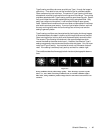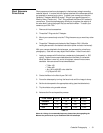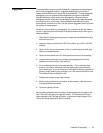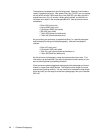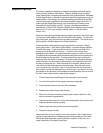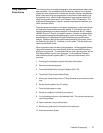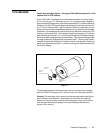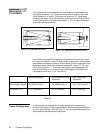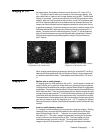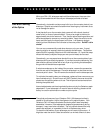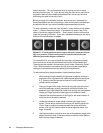
Celestial Photography • 57
This is the last form of celestial photography to be attempted after others have
been mastered. It is intended primarily for deep-sky objects, that is objects
outside our solar system which includes star clusters, nebulae, and galaxies.
While it may seem that high magnification is required for these objects, just
the opposite is true. Most of these objects cover large angular areas and fit
nicely into the prime focus field of your Celestron CM-1100 telescope. The
brightness of these objects, however, requires long exposure times and, as a
result, are rather difficult.
There are several techniques for this type of photography, and the one chosen
will determine the standard accessories needed. If, for example, you use a
separate guidescope, the camera attaches to the telescope with a T-Adapter
(#93633-A) and a T-Ring for your specific camera. However, the best method
for long exposure deep-sky astrophotography is with an off-axis guider. This
devise allows you to photograph through the telescope and guide simulta-
neously. Celestron offers a very special and advanced off-axis guider, called
the Radial Guider (#94176). In addition, you will need a T-Ring to attach your
camera to the Radial Guider.
Other equipment needs include a guiding eyepiece. Unlike piggyback photog-
raphy which allows for fairly loose guiding, prime focus requires meticulous
guiding for long periods. To accomplish this you need a guiding ocular with an
illuminated reticle to monitor your guide star. For this purpose, Celestron
offers the Micro Guide Eyepiece (#94171). Here is a brief summary of the
technique.
1. Polar align the telescope using the declination drift method.
2. Remove all visual accessories.
3. Thread the Radial Guider onto your Celestron CM-1100.
4. Thread the T-Ring onto the Radial Guider.
5. Mount your camera body onto the T-Ring the same as you would any other
lens.
6. Set the shutter speed to the “B” setting.
7. Focus the telescope on a star.
8. Center your subject in the field of your camera.
9. Find a suitable guide star in the telescope field. This can be the most time
consuming process.
10. Open the shutter using a cable release.
11. Monitor your guide star for the duration of the exposure.
12. Close the camera’s shutter.
Long Exposure
Prime Focus



